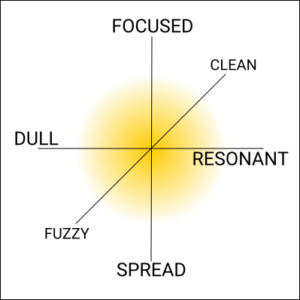This page is split into two parts. The first part is a brief discussion of commonly used words to describe brass instrument sound or tone. The second part is more important and it talks about the most common failing in the sound produced by brass players today that can be eliminated immediately by changing one aspect of playing technique.
Part 1: Tone or Sound? – A brief discussion by Rich Colquhoun
This discussion is about producing the correct tone on a brass instrument. The idea of a brass player’s sound may vary between different styles of music, but the idea of correct tone is universal.
This ideal tone made on a brass instrument is difficult to define for the simple reason that the English language lacks specific descriptors for the sound of a brass instrument. There are a few terms that are in common use, but they are very inaccurate in their nature. When choosing words to describe something we need to work with opposing pairs. You cannot understand cold without knowing its opposite (hot!).
So commonly the words used to describe the sound of a brass instrument will be dark (good for classical), bright (good for big band), round (good for ego) and thin (the sign of a weak player?). As you can read in the brackets, these pairs are also used to insinuate positive and negative qualities. Regardless of context these are the norms in popular opinion. However the problem with all of these terms is that they are not words that can be tied directly to a technical feature or deficiency in one’s playing. There are also more important features that are completely overlooked such as clarity, projection, clean articulation, consistency across the whole range of the instrument and control.
I would like to propose a new set of words that do describe correct and incorrect features of tone in a way that does not interfere with how that tone is then used in a musical context to create the musician’s sound.

Above you will see a graphic that illustrates a set of six terms for correctly defining tone. The centre is not the goal, in fact it is the top right. Brass players should always strive to create a tone that is focused, resonant and clean. This goal will lead to playing that is in-line with the rules of nature rather than fighting against them. It will result in much improved intonation and ease of playing. Once you can play with correct tone then you can adjust your equipment choices to find the sound that matches the music you play.
Part 2: How the TCE defines Correct Tone
If you were to examine the way that sound is produced on non-brass instruments there is always some form of percussive action which initiates the sound. Control of this percussive action is what has enabled composers to write with a range of articulations and make music expressive. On a piano there is a small hammer attached to each key that strikes the string associated with that key. Also of relevance you will note that there is also a damper that stops the vibrations as soon as the key is released. This mechanical action does not change if you are playing legato or staccato, allegro or lento. What changes is the way that the musician touches the keys. Similarly a classical guitarist must pluck a string for each note that they produce – there is a percussive action that creates the sound. Drummers literally hit things with sticks… the list goes on…
Most brass players today make the sound “Du-wah” for every note that they produce. The three principal French pedagogues of the 19th Century (F. Dauverne, J.B. Arban and M. Franquin) all mention avoiding this thick, undesirable (and not to mention out of tune) sound in tone production. This sound is created when the player allows the tongue to recede in their mouth when they play. This unnecessary and detrimental movement of the tongue causes the air pressure in the mouth to drop momentarily (“Duu”). Naturally a good musician is trained to correct the drop in pitch and will very quickly use their lips and air to do so, thus resulting in the “wah”. When you learn to hear this mistake you will notice that all but the best players, even in professional orchestras and on studio recordings have this problem that is so easy to prevent. For many people accuracy at speed and control above the stave are near impossibilities because of this issue.
Please take note that so far there has been no mention of choice of equipment required for changing to using TCE. Jerome Callet teaches people that there are certain mouthpieces that will prevent you from playing incorrectly and speed your transition to a better embouchure. However, such a mouthpiece may not suit your instrument and may not help you to create a characteristic sound required for the music that you choose to perform.